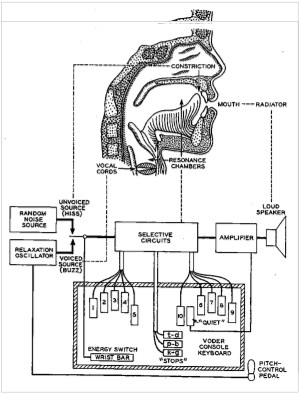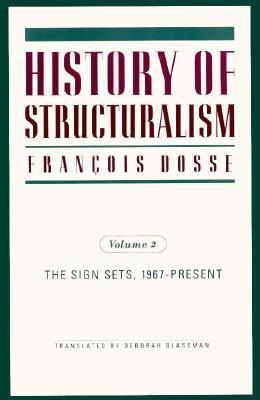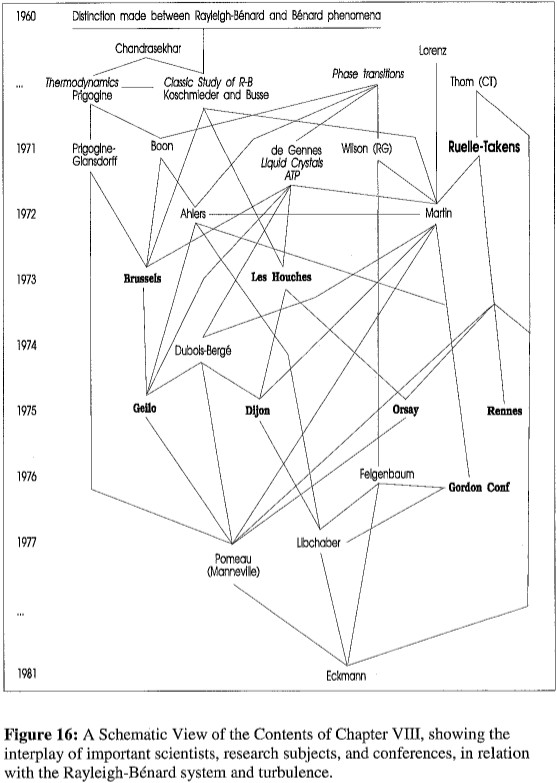David Aubin: A Cultural History of Catastrophes and Chaos: Around the Institut des Hautes Études Scientifiques, France 1958-1980 (1998)
Filed under thesis | Tags: · biology, catastrophe theory, chaos theory, history of mathematics, history of science, linguistics, mathematics, oulipo, physics, science, semiotics, structuralism, turbulence
“This is the story of a group of scientists who, in the local context of the Institut des Hautes Études Scientifiques (IHÉS), France, contributed to the elaboration of catastrophe theory and deterministic chaos theory. Starting with a study of the role of Bourbaki’s mathematics on the French intellectual scene (and especially with respect to structuralism), this dissertation examines the resources from topology, embryology, and linguistics used by René Thom to construct catastrophe theory.
It describes the foundation of the IHÉS by Léon Motchane in 1958 and the ideology of fundamental research that shaped it. It reviews the history of structural stability for differential equations, focusing on the work of Aleksandr Andronov and Solomon Lefschetz, among others, and the synthesis achieved in the 1960s by Stephen Smale at the University of California, Berkeley. These mathematical developments were used by Thom to develop new modeling practices. The IHÉS, which welcomed topologists such as E. Christopher Zeeman and Ralph Abraham, played a role in developing modeling practices based on recent advances in topology. A physics professor at the IHÉS, David Ruelle, together with Dutch mathematician Floris Takens, adapted the modeling practices of these ‘applied topologists’ and proposed a mechanism for the onset of turbulence, thereby introducing the concept of strange attractors. Looking at the history of fluid mechanics, I argue that Ruelle’s work displaced earlier emphases on fundamental laws, like the Navier-Stokes equations, and focused on the modes of representation rather than representations themselves. A certain Bourbakization of physics and the advent of the computer shaped this evolution.
Finally, focusing on convention, and taking the Rayleigh-Bénard system as a boundary system, various communities’ responses to the Ruelle-Takens model are examined, in particular hydrodynamic stability theorists, phase transition physicists and Pierre-Gilles de Gennes’s group, and chemical physicists orbiting Ilya Prigogine. Prior interest in developing interdisciplinary approaches for the study of turbulence helped the adaptation of a dynamical systems approach for the study of natural phenomena, greatly inspired by the work of Smale, Thom, and Ruelle.” (Abstract)
Ph. D. thesis
Princeton University
782 pages
single PDF (final section “Sources and Bibliography” missing; no OCR)
PDF chapters (from the author’s website)
Bernard Dionysus Geoghegan: The Cybernetic Apparatus: Media, Liberalism, and the Reform of the Human Sciences (2012)
Filed under thesis | Tags: · cybernetics, history of technology, liberalism, linguistics, structuralism, technology

“The Cybernetic Apparatus examines efforts to reform the human sciences through new forms of technical media. It demonstrates how 19th-century political ideals shaped mid-20th-century programs for cybernetic research and global science sponsored by the Rockefeller Foundation. Through archival research and textual analysis, it reconstructs how and why new media, especially digital technologies, were understood as part of a neutral and impartial apparatus for transcending disciplinary, ethnic, regional, and economic differences. The result is a new account of the role of new media technologies in facilitating international and interdisciplinary collaboration (and critique) in the latter half of the twentieth century.
Chapter one examines how political conceptions of communications and technology in the United States in the nineteenth century conditioned the understanding and deployment of media in the twentieth century, arguing that American liberals conceived of technical media as part of a neutral apparatus for overcoming ethnic, geographic, and economic difference in the rapidly expanding nation. Chapter two examines the development of new media instruments as technologies for reforming the natural and human sciences from the 1910s through the 1940s, with particular attention to programs administered by the Rockefeller Foundation. Chapters three and four examine the rise, in the 1940s and 1950s, of cybernetics and information theory as an ideal of scientific neutrality and political orderliness. These chapters demonstrate how programs sponsored by the Rockefeller Foundation, MIT, and other institutions shaped linguist Roman Jakobson’s and anthropologist Claude Lévi-Strauss’s efforts to redefine their fields as communication sciences. Chapter five considers how critics of cybernetics, including Noam Chomsky, Claude Shannon, and Roland Barthes, critically re-evaluated the claims of cybernetics to redefine the relations between technical research and the human sciences.”
PhD dissertation
Northwestern University & Bauhaus-Universität Weimar, 2012
262 pages
Author
Related paper by the author: From Information Theory to French Theory: Jakobson, Lévi-Strauss, and the Cybernetic Apparatus (Critical Inquiry 38, Autumn 2011)
PDF (6 MB, updated on 2021-3-9)
EPUB (2 MB, added on 2021-3-9)
François Dosse: History of Structuralism, 2 vols. (1991–) [BR-PT, EN, ES]
Filed under book | Tags: · 1940s, 1950s, 1960s, 1970s, anthropology, history, language, linguistics, literary theory, marxism, philosophy, psychoanalysis, semiotics, sociology, structuralism, unconscious


“Claude Lévi-Strauss, Roland Barthes, Jacques Lacan, Louis Althusser, Jacques Derrida, and Michel Foucault—the ideas of this group of French intellectuals who propounded structuralism and poststructuralism have had a profound impact on disciplines ranging from literary theory to sociology, from anthropology to philosophy, from history to psychoanalysis. In this long-awaited translation, History of Structuralism examines the thinkers who made up the movement, providing a fascinating elucidation of a central aspect of postwar intellectual history.
François Dosse tells the story of structuralism from its beginnings in postwar Paris, a city dominated by the towering figure of Jean-Paul Sartre. The work of Saussure became the point of departure for a group of younger scholars, and the outcome was not only the doom of Sartre as intellectual leader but the birth of a movement that would come to reconfigure French intellectual life and would eventually reverberate throughout the Western world.
Dosse provides a readable, intelligible overall account, one that shows the interrelationship among the central currents of structuralism and situates them in context. Dosse illuminates the way developments in what are usually distinct fields came to exert such influence on each other, showing how the early structuralists paved the way for later developments and for recent discourses such as postmodernism. The cast of characters related by Dosse includes those mentioned above as well as Roman Jakobson, Julia Kristeva, Pierre Bourdieu, Gilles Deleuze, Félix Guattari, Tzvetan Todorov, and many others. Chapters are devoted to major figures, and Dosse has done extensive interviews with the major and minor figures of the movement, furnishing an intellectual history in which historical players look back at the period.
This first comprehensive history of the structuralist movement is an essential guide to a major moment in the development of twentieth-century thought, one that provides a cogent map to a dizzying array of personalities and their ideas. It will be compelling reading for those interested in philosophy, literary theory, sociology, anthropology, linguistics, and psychoanalysis.”
First published in French as Histoire du structuralisme, Éditions La Découverte, Paris, 1991, 1992
English edition
Translated by Deborah Glassman
Publisher University of Minnesota Press, 1997
ISBN 0816622418, 9780816622412 & 0816623716, 9780816623716
488 & 534 pages
Publisher (EN)
História do estruturalismo I (BR-Portuguese, trans. Álvaro Cabral, 1993, added on 2024-1-20)
História do estruturalismo II (BR-Portuguese, trans. Álvaro Cabral, 1994, added on 2024-1-20)
History of Structuralism, 1: The Rising Sign, 1945-1966 (English, trans. Deborah Glassman, 1997, via falsedeity)
History of Structuralism, 2: The Sign Sets, 1967-Present (English, trans. Deborah Glassman, 1997)
Historia del estructuralismo I (Spanish, trans. María del Mar Llinares, 2004)
Historia del estructuralismo II (Spanish, trans. María del Mar Llinares, 2004)


